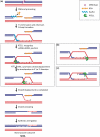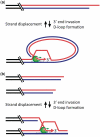RTEL1: an essential helicase for telomere maintenance and the regulation of homologous recombination
- PMID: 21097466
- PMCID: PMC3061057
- DOI: 10.1093/nar/gkq1045
RTEL1: an essential helicase for telomere maintenance and the regulation of homologous recombination
Abstract
Telomere maintenance and DNA repair are crucial processes that protect the genome against instability. RTEL1, an essential iron-sulfur cluster-containing helicase, is a dominant factor that controls telomere length in mice and is required for telomere integrity. In addition, RTEL1 promotes synthesis-dependent strand annealing to direct DNA double-strand breaks into non-crossover outcomes during mitotic repair and in meiosis. Here, we review the role of RTEL1 in telomere maintenance and homologous recombination and discuss models linking RTEL1's enzymatic activity to its function in telomere maintenance and DNA repair.
Figures


Similar articles
-
Harmonin homology domain-mediated interaction of RTEL1 helicase with RPA and DNA provides insights into its recruitment to DNA repair sites.Nucleic Acids Res. 2024 Feb 9;52(3):1450-1470. doi: 10.1093/nar/gkad1208. Nucleic Acids Res. 2024. PMID: 38153196 Free PMC article.
-
[RTEL1 (regulator of telomere elongation helicase 1), a DNA helicase essential for genome stability].Med Sci (Paris). 2013 Dec;29(12):1138-44. doi: 10.1051/medsci/20132912018. Epub 2013 Dec 20. Med Sci (Paris). 2013. PMID: 24356145 Review. French.
-
RTEL1: functions of a disease-associated helicase.Trends Cell Biol. 2014 Jul;24(7):416-25. doi: 10.1016/j.tcb.2014.01.004. Epub 2014 Feb 25. Trends Cell Biol. 2014. PMID: 24582487 Review.
-
RTEL1 contributes to DNA replication and repair and telomere maintenance.Mol Biol Cell. 2012 Jul;23(14):2782-92. doi: 10.1091/mbc.E12-03-0179. Epub 2012 May 16. Mol Biol Cell. 2012. PMID: 22593209 Free PMC article.
-
The Arabidopsis thaliana homolog of the helicase RTEL1 plays multiple roles in preserving genome stability.Plant Cell. 2014 Dec;26(12):4889-902. doi: 10.1105/tpc.114.132472. Epub 2014 Dec 16. Plant Cell. 2014. PMID: 25516598 Free PMC article.
Cited by
-
Telomerase Regulation from Beginning to the End.Genes (Basel). 2016 Sep 14;7(9):64. doi: 10.3390/genes7090064. Genes (Basel). 2016. PMID: 27649246 Free PMC article. Review.
-
Harmonin homology domain-mediated interaction of RTEL1 helicase with RPA and DNA provides insights into its recruitment to DNA repair sites.Nucleic Acids Res. 2024 Feb 9;52(3):1450-1470. doi: 10.1093/nar/gkad1208. Nucleic Acids Res. 2024. PMID: 38153196 Free PMC article.
-
R-loops highlight the nucleus in ALS.Nucleus. 2015;6(1):23-9. doi: 10.1080/19491034.2015.1004952. Nucleus. 2015. PMID: 25587791 Free PMC article. Review.
-
Repair of DNA double-strand breaks in plant meiosis: role of eukaryotic RecA recombinases and their modulators.Plant Reprod. 2023 Mar;36(1):17-41. doi: 10.1007/s00497-022-00443-6. Epub 2022 Jun 1. Plant Reprod. 2023. PMID: 35641832 Review.
-
Regulation of gene expression by the BLM helicase correlates with the presence of G-quadruplex DNA motifs.Proc Natl Acad Sci U S A. 2014 Jul 8;111(27):9905-10. doi: 10.1073/pnas.1404807111. Epub 2014 Jun 23. Proc Natl Acad Sci U S A. 2014. PMID: 24958861 Free PMC article.
References
-
- Blackburn EH. Switching and signaling at the telomere. Cell. 2001;106:661–673. - PubMed
-
- de Lange T. Shelterin: the protein complex that shapes and safeguards human telomeres. Genes Dev. 2005;19:2100–2110. - PubMed
-
- Griffith JD, Comeau L, Rosenfield S, Stansel RM, Bianchi A, Moss H, de Lange T. Mammalian telomeres end in a large duplex loop. Cell. 1999;97:503–514. - PubMed

